
Pellet pioneer: John Swaan and the industrial wood pellet trade origins
April 24, 2023
By Hannah Campbell
FutureMetrics' Hannah Campbell shares the story of John Swaan, one of the pioneers of the industrial wood pellet trade.
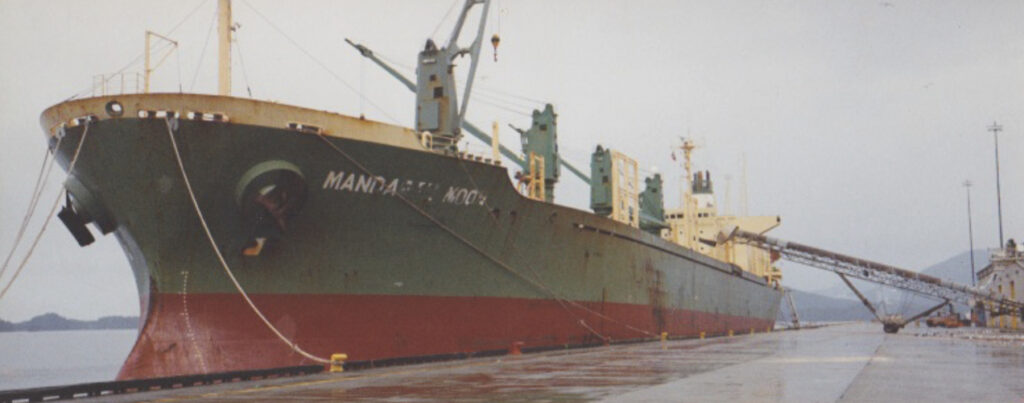 The vessel Mandarin Moon being loaded with Swaan’s pellets on February 9, 1998 in Prince Rupert, B.C. Photo courtesy FutureMetrics.
The vessel Mandarin Moon being loaded with Swaan’s pellets on February 9, 1998 in Prince Rupert, B.C. Photo courtesy FutureMetrics. Twenty-five years ago, the first of many large bulk shipments of industrial wood pellets produced by John Swaan travelled from British Columbia to the Helsingborg Energi power plant in Sweden. John Swaan’ numerous bulk shipments after that first shipload, marked the birth of today’s multibillion dollar industrial wood pellet industry.
The person behind this accomplishment, John Swaan, tells some of the stories which led him to that contract worth $1.67 million in 1998.
The early days
Being born and raised on a dairy farm in the Fraser Valley of British Columbia provided John with the beginnings of his entrepreneurial spirit and mechanical aptitude.
One of John’s first part time jobs was at a feed mill, where he quickly went from unloading box cars of grain to learning the operations side of pellet mills by necessity; the afternoon guy tending the pellet mills would go for a nap by the boiler and say, “Hey kid, take care of the pellet mills would you,” which John did. “The intrigue of a farm kid always anxious to get in front of something that ran or made noise (or in this case, made pellets) was pretty damn exciting – for $2 an hour!” John says.
John’s brothers Jim and Rob moved to Quesnel, B.C., in the early 1980s to start a dairy farm and John soon joined them with his intent to start a feed mill to support the farm. The livestock feed industry is low margin and very cost intensive, so out of desperation John was always on the lookout for an alternative to reduce costs and improve margin – by the late ‘80s, one such idea came up.
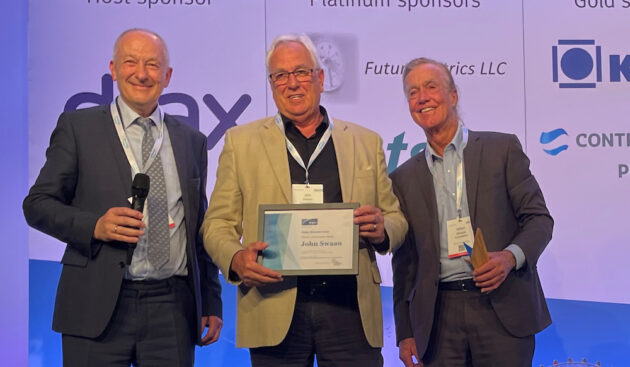
John Swaan (centre) accepts a lifetime achievement award at the Argus Biomass Conference in London on April 18, 2023. Photo courtesy FutureMetrics.
In 1988, he made his first attempt at wood pellets after he attended an auction looking for used parts for the feed mill and met another guy competing for parts. The guy was a friend of Jerry Whitfield of Whitfield stoves, who told him that the need for wood pellets in the Seattle area was growing; largely because pellet stoves had just come on the market as a replacement for wood burning stoves.
At the time, most of the Northern B.C. sawmills were burning their shavings and sawdust in bee-hive burners to rid themselves of the wood waste they were generating by the hundreds of thousands of tons per year. Hence, John saw an opportunity in his backyard to take on these wood waste residues, turn them into wood pellets, and hopefully improve the profit margin of his mill.
On a Sunday afternoon, so as not to interrupt and contaminate his feed mill, he made first attempt at manufacturing wood pellets. The way John tells the story, his kid brother Jim was trying to take a Sunday nap and came out of the house wondering what the hell was the cause of the racket, to which John replied he was “trying to make wood pellets,” to which Jim replied, “are you out of your mind?” Note that Jim Swaan and brother Rob Swaan went on to be quite successful as the founders of Pinnacle Pellet (now Drax).
After about four hours of the trial and generating maybe a couple hundred pounds of wood pellets, John concluded a bit of a learning curve was necessary. His first lesson was when he realized that gear driven machines don’t work well because the fibre is so abrasive and tough on the equipment; a belt driven machine like the Sprout (now Andritz) machine would help absorb some of the shock of the abrasive nature of wood fibre.
Building Pacific Bioenergy
By 1994, he was able to negotiate a partnership with the Carrier Group, a family-owned lumber company to build one of Canada’s first stand-alone wood pellet plants.
Carrier’s motivation to get in business with John was that the pulp mills would take on the chips, shavings, and sawdust, but every one of the sawmills were still running beehive burners, which B.C. was working aggressively to eliminate at the time. The forestry and sawmill industry needed a solution to the ban on open burning of sawmill residuals because they had no other outlet for this waste wood, hence the pellet mill deal made as much sense to them as it did to John. His partner at the time looked at the situation like a septic tank and likened John taking the residues off his hands to him being able to flush his toilet. With time, this arrangement began to treat the residues like a product which was no longer free but suited both parties.
The plant was a simple plan that followed pretty much the same footprint as they all do today, using mostly used equipment except for two brand new pellet mills: Andritz VM26 (now known as the LM26). These VM26 pellet mills were among the first to be installed exclusively for wood pellet production.
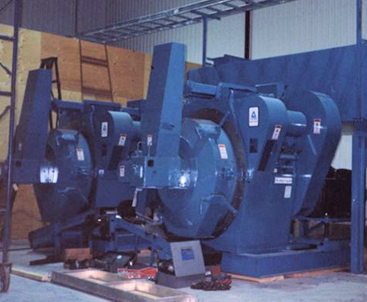
John’s first pellet presses – Andritz VM26. Photo courtesy FutureMetrics.
Carrier Forest Products (Carriers fabrication shop) gave John a free run of the place, and along with one fabricator, Chris Penner, and one apprentice millwright, Terry Foster, it took John six months to build the mill. He worked through Christmas that year, starting to install the working pieces so that they could cold commission the mill in February.
To commission the plant, he took on people he thought would have some capacity as operators but ended up doing most of the commissioning and operating of the plant himself. “For the first six months as I was trying to train and clone these people to run this thing 24/7, I stayed on site sleeping on a cot in our ‘band-aid’ room where my wife Trudy would bring me supper,” John says.
Once he had the plant operational, the heating pellet market in the Seattle area started crashing. In 1995, the natural gas grid in Seattle and its surrounding markets expanded rapidly, dampening the pellet market that had been growing at 30,000-40,000 tons per year up to 400,000 tons by the time John was building his plant. Lignetics and several other plants in the Pacific Northwest already had a foothold on this market, and since he was the furthest away (about 600 miles) from a now a shrinking market, it became very difficult for John to compete.
However, John did manage to negotiate a verbal commitment from Home Base (like Home Depot today) for 15,000 bagged tons a year, but it fell through, and John had accumulated 9,000 tons of bagged product in the plant’s yard with no home for it. His partner was concerned.
North America’s first large bulk shipment of wood pellets
Desperation drove John to look for other options. He learned by word of mouth (these were pre-internet days) that in Sweden they had come out with a type of pellet burner that converted oil boilers to pellets. To sell his pellets, it made sense that this technology would be a welcome addition to his local market, so John managed to make a connection with a Swedish Canadian, Staffan Melin, who assisted with arranging a tour of pellet burner manufacturers in Sweden for John to learn about the technology. “I took my visa and landed in Stockholm, Sweden on a grey drizzly afternoon like you see in the movies,” John says. The tour included an installation in a hotel (a fairly old hotel) that had three boilers. Two were still oil fired, but one was converted to this pellet gun system.
It was then that John noticed there was a meter on the wall measuring the hot water – that’s when it clicked for him that “you’re selling energy by the MW, the calorific value that’s in the product,” he says.
This realization would fundamentally change the way John looked at the wood pellet and hasten a new global industry into play.
He learned on that trip that Stockholm Energy was consuming 250,000 tons of pellets to displace coal that year and while it seemed the EU would have a hard time getting the quantity of wood pellets it needed, there was a genuine interest in carbon reduction.
With the assistance of Staffan Melin again, John acquired a list of all the utilities in Sweden that were at a port. He sent bagged samples for six weeks to those utilities and sparked interest, causing him to take another half dozen or so trips back to Sweden in the following three months. He faced questions and comments like the argument that it was fundamentally wrong to bring wood pellets all the way from Canada to Sweden, but he thought, what is the difference between transporting wood pellets and coal or oil?
By learning that there was an ISO standard to determine net calorific value (NCV) and thus basing the price on this, John negotiated the first historic contract with Helsingborg Energi.
The basis of determining the CV within this three-year contract is still what is being utilized today in offtake agreements around the globe.
Upon signing this contract, John hadn’t had a legal review of the contract, hadn’t fully negotiated shipping by sea, didn’t have a terminal to ship out of, had no rail cars, and hadn’t talked to the rail company yet, but he had enough of a baseline to know what numbers would make it work.
Asking John now if he thought it was crazy at times, he replies, “I don’t think so, I was just so determined and so into what we needed to do…at 44, when I made the decision and commitment to do this, I was fine with it but if you ask me now at near 70 if I’d do it again, my head says no. My heart says hell yeah. I’m sure a lot of people thought I was crazy, but it was just one challenge after another, and I needed to do what I had to in order to get it done.”
After signing the contract, John’s work was far from over. He needed to figure out the logistics of how to get his wood pellets from Prince George, B.C., to Sweden – no small feat. Having done a lot of business in the feed industry and with grain dealers, he contacted a guy he used to buy from at Continental Grain about a terminal at Prince Rupert they weren’t using. They said he could use the conveyance system and terminal, and at one point even offered to sell it to him (which he didn’t take them up on). They had storage at the terminal, but only for about 6,000-7,000 tons, so almost 10,000 tons had to be stored in rail cars.
John made his first call to Canadian National railroad (CN) because they had a rail line to Prince Rupert. But they didn’t have private rail cars so he would have to lease them. The first 40 cars John leased then remained in service right up until Pacific Bioenegy (often called PacBio), and they might have been taken on by Drax since.
He negotiated a rate agreement and leased on a monthly basis with terms that were really good by today’s standards – but he basically had to go across town and load in CN’s yard where they allowed him to put his cars on their siding to load. He pulled the cars with his pickup, until it wore out, and then brought in a tractor from his brother’s farm in Quesnel to move them – that was until a rail car ran over the tractor one night!
In the meantime, John was also in search of a ship. Once again Staffan Melin whom had had some experience in the shipping world in prior years and was able to help John eventually convince an Asian shipping company to take on a bulk cargo of wood pellets. At the time, no one had moved wood pellets this way, so it was an unknown. It was also how John learned he needed a shipping agent as well to handle the vessel at the port.
For John, much of the shipping world was learned on the fly including the lingo and terms. Sometimes the captain of a vessel would invent some nonsense to not to untie and depart generating demurrage fees, so learning to pick up on these tricks was essential.
The original shipping schedule in the contract was moved up about six months, which led to a turn of events requiring John to ramp up production: de-bag the 9,000 tons in inventory (Operation De-Bag), secure any extra volume of pellets his brothers Jim and Rob Swaan of Pinnacle Pellet (now Drax) had , and secure any the Johnston brothers Dean and Gary of Princeton (also now Drax) had to meet the deadline of the first shipment.
During this time, John and his team, lead by Paige Anderson, faced the challenge of getting 9,000 bagged tons unbagged, transported across town to CN’s rail siding, loaded on the railcars, and getting those cars to the port terminal for storage. The ship was scheduled for mid-February, so Operation De-Bag had to happen in short order: running 24/7 with 120 people it took them 19 days.
It was also during this period that John wore out his pickup and the tractor got run over. He’d place a box of donuts (or beer in the afternoon) on the rail car hook and whoever went to hook onto the car got the reward. Whatever it took to meet the deadline, John made it happen. It was also during this time CN responded to his request for more railcar “pulls and spots” by telling him that he was getting better service than they were giving to GM in Ontario.
Sometime around this period John had the contract he’d signed with Helsingborg Energi reviewed by an attorney when he went for financing, which he hadn’t had up until this point in time. Legal review revealed that John had accepted the clause that if the utility had to use coal because he didn’t deliver on the pellets, he’d pay the coal taxes. The attorney absolutely thought John was crazy, but in John’s words, “I told the lawyer if I didn’t show up in Helsingborg with the cargo, I’d be bankrupt anyway so they wouldn’t have anyone to collect from!”
He did have a hard time getting financing because he was pulling off an entirely new feat that the financing world wasn’t yet familiar with. Managing the cash flow turned out to be the biggest challenge for John and his team to manage for the first shipment and in his words, “I would never want to live through it again.” It was this challenge that instantly turned John’s dark brown hair white.
John’s contract for payment with Helsingborg was 50 per cent payment when the PacBio presented the original shipping documents in Helsingborg, Sweden (airmail, not fax or email). The contract was also CIF which meant payment for the vessel was to be paid within 36 hours of when it left port. The balance of payment was paid upon the final discharge of the vessel and the analysis of the CV was performed, so for the better part of six months the cash flow was totally tied up in this situation.
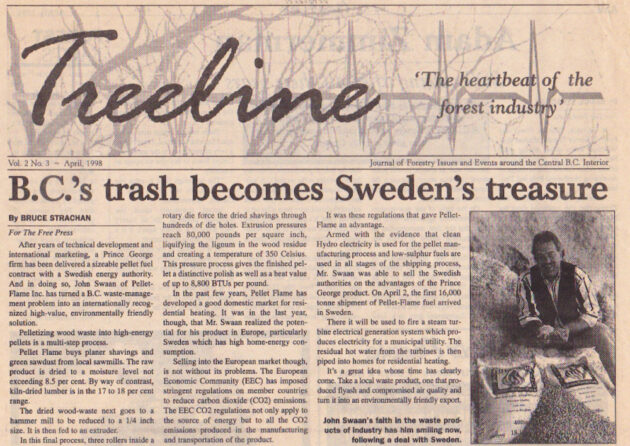
A 1998 story on John Swaan. Photo courtesy FutureMetrics.
The financing didn’t really get better in the early years until the industry was better established. Those that followed John’s pioneering work likely had a much easier time of attracting reasonable financing.
The next country he did business with was Denmark, in the form of several shipments in the 2000s. John visited utilities and power plants in the Netherlands, Belgium and finally Drax in 2001 (where he just drove in with no security at the time!).
The earliest shipments to Japan were in 1999 to Kansai for sampling. And he did regular business with another firm shipping containers of wood pellets for livestock bedding. A Kobe beef farm he visited in Japan said their bedding changeout days increased by four days (from three to seven) thanks to the absorbing qualities of the pellets compared to straw, shavings, or sawdust.
John’s next role as a pioneer
Unfortunately, one of John’s shortcomings was the ability to attract adequate financing to support the growth of the company, mostly due to the perception of John as a risk taker. That, compounded by the issue that most all the company’s business was with foreign countries, caused conventional banks to shy away from supporting the business with operating funds backing the inventory, even though John was doing business with major utilities which had budgets larger than the GDP of some small countries.
Despite the company’s difficult financial challenges, it maintained positive cash flow and managed to get through financially without shutting down, and employees and suppliers were kept whole. However, John was forced to relinquish control of his company.
In 2004, John left his company and by 2006 became the founding executive director of the Wood Pellet Association of Canada (WPAC). Prior to that, with the assistance of “Forest Renewal” (a B.C. Ministry of Forests initiative to advocate value-added industry) in cooperation with the three other wood pellet companies in B.C., John had instigated the formation of the B.C. Wood Pellet Manufactures Association, a B.C. version of the Pellet Fuels Institute to promote awareness of wood pellets.
During these early years with WPAC, which John confirms Gordon Murray is doing a wonderful job with now, the industry was in a state of desperation.
Freshly produced wood pellets emit carbon monoxide (CO) and the shipping industry was coming back at the shippers saying that wood pellets would be labeled as hazardous goods and would command an additional $5 to $15 per ton freight rate if the level of CO generated and why it is generated could not verified by an accredited research institution. The industry’s margins would have been seriously challenged having to pay another $5-$15 a ton in shipping costs.
Staffan Melin as WPAC’s research director lead a team at the University of British Columbia (UBC) to successfully assist with the research necessary to document CO actively and levels for IMO and shipping documents that are now presented to all vessels and/or logistics companies handling, shipping, or storing wood pellets around the world.
John and his brother Jim built the reactor at UBC that is utilized to this day for conducting research on wood pellets including rigorous studies of CO formation and self-heating. The research teams discovered that concentrations of 16,000 ppm of CO were possible with the oxygen levels down to just six per cent.
John sent these findings out to the entire industry, including anyone holding pellets in any kind of confined space. The message was simple: don’t go in confined spaces where wood pellets are stored until it’s fully ventilated, or you can measure that it’s safe. Results from the research initiated by John and sponsored by WPAC at UBC have made the industry safer.
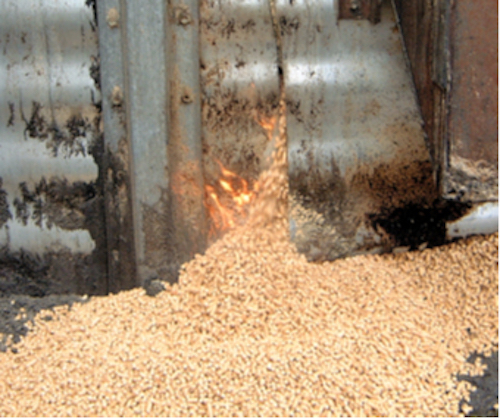
Flame from the gas given off by pyrolyzing pellets inside the storage silo. Photo courtesy FutureMetrics.
John was no stranger to the dangers of silo fires by this stage – he’d experienced one in B.C. that blew off the top of his silo. The conveyer had gone down, and they’d cut a hole in the side of the silo where he could feel the hairs on his arm getting burnt when close to the silo’s exterior. As soon as the pellets began to flow from the cut, a flame appeared. John took a picture of the flames before dousing the fire and continuing to remove the pellets from the hole they had cut in the silo. He had no idea at the time that the flame was from the pyrolysis gasses being generated in the oxygen starved core of the incident.
At one point a break for coffee was required and upon going inside to make a cup of coffee, he’d heard a loud boom outside and the whole roof of the silo was gone. No one was injured, but it raised his awareness on how not to deal with a silo fire incident.
It also spurred John to later have WPAC, in co-operation with the Swedish Research Institute, fully research how to deal with silo fires. A report Silo Fire Handbook authored by Henry Persson with assistance from WPAC research director Staffan Melin has become the go to guide for dealing with wood pellet silo/dome fire incidents.
A few dead ends
By 2009, John went to Georgia to work on a project similar (and very close to) to where the Georgia Biomass pellet factory is now located. It was only about 50 miles down the road from Georgia Biomass, which was also going to produce close to one million tons of wood pellets. The owners of the project didn’t pay heed to John’s warnings about the strain both projects would have on the surrounding wood basket. This group also insisted on exploring torrefaction, which John tried to assist with, but no torrefaction technology existed in North America that would work at the scale they needed, and much to John’s dismay they wouldn’t consider minimizing the technology risk by producing white pellets first.
At one point John was brought to meet with potential investors on Wall Street (he says it was just like in the movies looking over Central Park) to raise $300 million for their project. When asked, John told the potential investors that the risk was too high and if he were in their shoes, he wouldn’t fund it. In John’s words, “my employer wasn’t too happy on the flight on his private jet back home. By the time we made it back to Jacksonville, I was not fired yet, but was told to get on the next plane to Europe and find a technology that works. I found a single one that was actually working when I visited, but they had some financial issues.”
Ultimately, John and his employer went back over to the Netherlands where his employer walked in the door and bought the entire company and its technology – with John’s new task to make torrefaction work. He and his wife spent about a year in the Netherlands, which they loved, but when his contract was up for renewal, he’d had his fill of a project that was not headed in a positive direction, so he resigned and returned back home to Canada.
More than a decade with FutureMetrics
As John would say, the rest is history. He ran into Bill Strauss of FutureMetrics at a conference in Miami and agreed to do some consulting work which, ironically, was for a project that was just about two hours away from John’s winter home in southeastern Mexico. Since then, John’s been working with FutureMetrics on pellet projects large and small on every continent except Antarctica.
His expertise is hard won and a combination of many tough lessons along the way that have been forged out of determination in the face of desperation; these lessons have helped to create and support the multibillion-dollar wood pellet industry we all know today.
Hannah Campbell is a Logistics Specialist for FutureMetrics. This article was originally published on futuremetrics.info, republished with permission.
Print this page